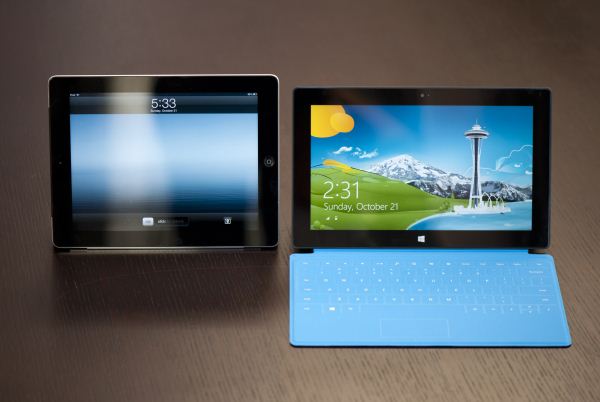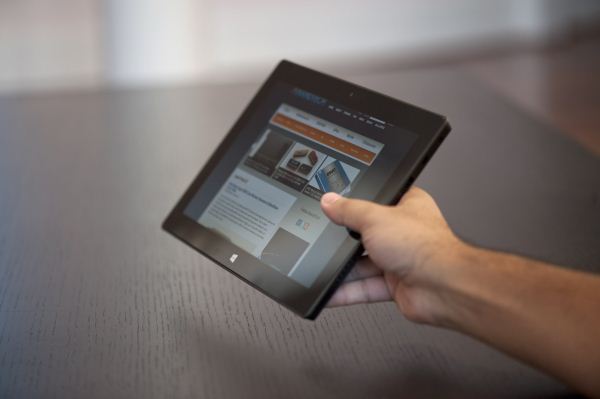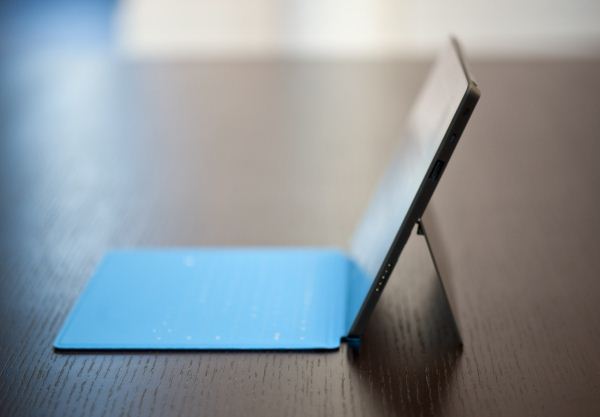Microsoft Surface Review
by Anand Lal Shimpi on October 23, 2012 9:01 PM EST- Posted in
- Tablets
- Microsoft
- Mobile
- Surface
- Windows RT
Surface: Simply Put
Surface is very well built and extremely well designed. It’s easily among the best built products I’ve had the opportunity to handle, and definitely puts a lot of earlier attempts from far more experienced companies to shame. I wouldn’t say that it looks better or worse than the iPad, it’s simply different. I talked about perspectives earlier, Microsoft’s perspective on tablets is a bit more utilitarian than Apple’s and Surface’s design reflects that reality.
Where the iPad is curvy and without any IO expansion, Surface is squared off with 22-degree beveled edges. The iPad features a light aluminum finish while Surface contrasts with its dark Magnesium surface. Not better or worse, just different.
Surface is both larger and heavier than the iPad, both design decisions on Microsoft’s part to built a device that could better deal with Windows RT’s multitasking capabilities as well as make room for a comfortable typing area when used with one of its two keyboard covers.
The added weight is offset by superb internal weight distribution. Microsoft claims a lower moment of inertia by more evenly distributing weight inside Surface’s chassis. I don’t know that I’d consider Surface light but it is very comfortable to carry around. It’s not quite like porting around a pad of paper, but carrying Surface feels very natural.
The focus on weight distribution results in a device that is honestly comfortable to hold in tablet mode and very comfortable to carry around. The more squared design of Surface actually makes in hand feel more like a book than the iPad, which was an early goal for the device.
The chassis is built out of an injection molded Magnesium, which gives it a very different feel to most machined Aluminum or plastic tablets we’ve used in the past. Microsoft calls this process VaporMg (vapor-mag) and I have to say that I’m pleased with the outcome. Surface’s finish is smooth and lacks the same texture that we’ve come to expect from machined Aluminum. The device feels very durable and doesn’t seem to scratch or scuff easily, although I didn’t purposefully try to mar my review unit over the past week. Striking a balance between robustness and light weight is very tricky business when building mobile devices, Surface easily falls on the robust side of the scale without feeling overly heavy. I never felt that the device was too fragile.
The power of Surface is in its flexibility. Microsoft’s talents not as a software developer nor as a parts assembler are what make Surface great here, rather its design and manufacturing intuition. I would’ve expected Surface to come from a company that had much more experience in designing and building tablets and PCs, not from a company that’s traditionally known for putting stickers all over them.
Surface’s flexibility comes from three areas: the tablet itself, the integrated kickstand and the optional Touch/Type covers. In tablet mode, Surface is Microsoft’s take on the new wave of tablets. It delivers the same intimate content consumption experience that you’d get from other tablets but with the added benefits of Windows RT, such as improved multitasking and better task switching.
Surface also features an integrated kickstand, also made out of the same VaporMg process as the rest of the chassis.
Microsoft wants you to be able to quickly transition between notebook, tablet and display modes. It’s rare that I see a goal so well executed. Surface really masters the art of quick transitions between all three modes. I can be in word, typing out this review and quickly switch to a tablet mode where I’m browsing the web with the keyboard cover folded neatly behind the display. If I need to respond to a comment or answer an email, I can just as easily switch back. The kickstand is a necessary part of enabling these quick transitions, and it does its job well.
There’s only one side of Surface that has a cutout for you to easily flick the stand out from its resting place. The kickstand’s range of motion does take some getting used to. It’s spring loaded enough to pop out at good velocity (and strong enough to pinch your skin nicely if you close it on a part of your finger by accident). When deployed it positions the top of Surface away from you at a 22-degree angle, matching the bevel of Surface’s edge.
With a fixed angle of deployment the kickstand doesn’t always deliver the best viewing experience, although it’s usually good enough. The kickstand is perfect for desk use and even for using while reclined on a couch or even in bed. Where it does fall short is if you’re hunched over Surface on an airplane in coach without a lot of room to move the device away from you. In those situations you’re going to find that you’d wish the kickstand could open at a wider angle.
Microsoft is particularly proud of the acoustics and feel of the kickstand. In my experience I felt the kickstand actuated nicely but I don’t know if I’d go so far as to draw the luxury car door comparison. The best way I can put it is the kickstand never feels cheap and doesn’t rattle, it works and gives you the confidence that it’ll always work and not just break after half a year. It’s not often that I find a substantial moving part on a mobile device that I feel is more functional than gimmicky. Surface’s kickstand is definitely a job well done.
The third element of Surface that makes it a very flexible device is also responsible for the splash of color in the design that gives the otherwise business appearance a consumer twist. I’m talking about Surface’s Type and Touch Covers.



















235 Comments
View All Comments
sviola - Wednesday, October 24, 2012 - link
Care to source the claim that A6 performs the same as x86 core processors per clock cycle?blandge - Wednesday, October 24, 2012 - link
"A6 is as fast as Intel per clock cycle. (and yes: I understand that A6 is dual core and intel is quad + clocked much higher. But the fact is that A6 is as fast per clock cycle. ARM will replace X86)"This simply isn't true. The A6 scored 908ms on the SunSpider browser benchmark and a 2700k scores about 135ms (Lower is better). That's about 6x better, and SunSpirder is a SINGLE CORE benchmark.
Brainling - Wednesday, October 24, 2012 - link
Are you serious with this about the A6? The A6 is NO WHERE NEAR as fast as full on Intel silicon. It's not even in the same ballpark. Maybe if you're comparing it to Atom?An Ivy Bridge full silicon CPU is in another league over the A6. Of course, they aren't meant for the same purpose. Even taking the faster clocks in to account (~4x the clock speed), the Ivy Bridge regularly scores 6-7 times the execution scores of an A6 in synthetics. That's not pure clock speed, that's also a flat better CPU.
I swear...some of this stuff is just mind blowing. What in the world would have ever made you think an A6 was "clock for clock" as fast as Intel's best offerings? Also, the XBox 360 doesn't use an Intel CPU or an x86 CPU...it's a Motorola PowerPC. Might wanna check your facts next time.
Kevin G - Tuesday, October 23, 2012 - link
A typo: "Microsoft offers Touch Cover in six colors black, white, magenta, cyan and red." Not sure if a color is missing or you meant five (though five pictured).Anand, you've been taking the Surface around judging the examples in the article. Any chance it was with you during the iPad mini event? I can image the looks being worse than when you tried to make a call at the iPhone 5 event.
"Simply typing quickly in Microsoft Word maxes the single threaded performance of Tegra 3’s ARM Cortex A9 cores." It does seem odd that one of Surface's biggest selling points on the software side is a self inflicted wound. Office should be the premiere application for MS to show case, not bloatware that'd deserve to sit in the sloth exhibit at a zoo. Was Office even usable?
Ryan Smith - Tuesday, October 23, 2012 - link
Apparently we can't count today. It is indeed five colors, not six.ssiu - Tuesday, October 23, 2012 - link
Finally, some objective Windows RT versus Windows 8 Atom tablet performance comparison on the net -- thanks anandtech. Definitely no reason for me to consider Windows RT.Zink - Tuesday, October 23, 2012 - link
Yep this is silly. The only reason for RT is to let OEM's compete <$500 with Apple and to emulate other walled garden ecosystems.Atom should have been launch hardware for a better user experience. Hasn't Apple success shown that UI is #1?
dagamer34 - Tuesday, October 23, 2012 - link
Basically it seems like Microsoft built a rather competent product, and when we see Windows RT tablets with stronger hardware like Tegra 4 or S4 Pro, it should be a great experience.Considering this is Microsoft's first hardware computer, they could have done a LOT worse, and there are some things you only learn by actually shipping a product. For a 1st gen release, that's pretty good.
shompa - Wednesday, October 24, 2012 - link
Thats is one of MSFT problem. Since they control the hardware, we wont see the crazy Android/PC hardware wars. How long time for MSFT to write drivers/support Tegra4 or any other fast SoC?Just look at Windows Phone. Nokia have the killer "Pure View" and MSFT don't support it.
(And thats is why Nokia will die with only MSFT support)
notanakin - Tuesday, October 23, 2012 - link
"Microsoft’s talents not as a software developer nor as a parts assembler are what make Surface great here, rather its design and manufacturing intuition."Er, so what is it that makes Surface great here? Almost sounds like the less talent you have, the greater the product. (In that case, please contact me for insanely great product designs.)